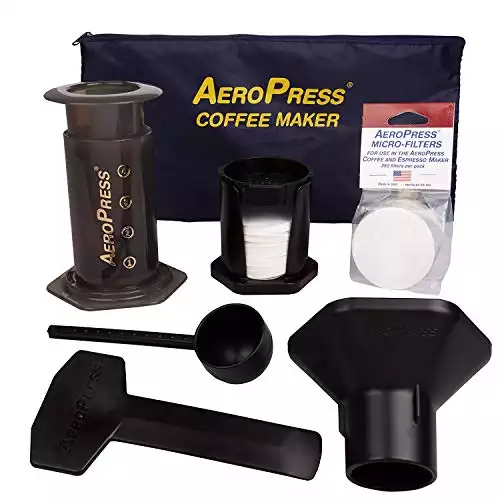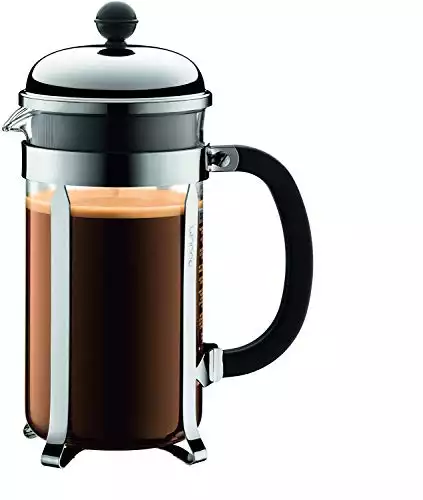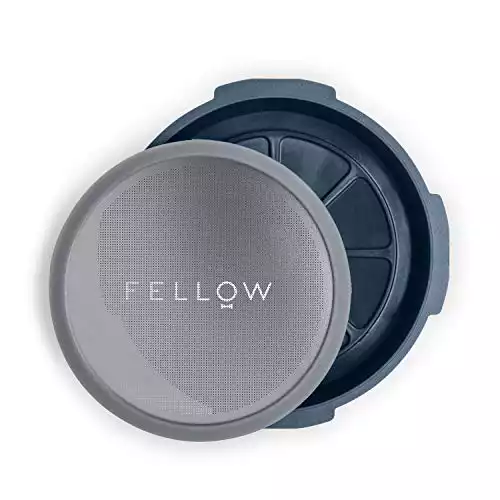AeroPress VS French Press
The AeroPress vs French Press debate is a heated one among coffee lovers. Which one gives the best results? Which one is easier to use? Which brews up the most flavorful cup?
Although both of these brewing methods have the word “press” in the name, AeroPress and French Press are worlds apart in the results they give you in the cup.
In this article, I break down the differences between the two brewing devices so you can find the perfect brew method for you.
What Is an AeroPress?
You’ve probably seen a French Press, and you may have had French Press coffee. But that odd-looking AeroPress might be completely new to you.
Invented in the United States by Alan Adler, AeroPress is a relative newcomer on the coffee scene. It came into the world in 2005 and took the coffee industry by storm.
The AeroPress looks a bit odd, or at least I get a lot of odd looks when I introduce it to people for the first time. It does not look at all like other coffee brewing methods. In fact, it resembles a medical device, sort of like a huge syringe.
It’s made of two cylindrical pieces of plastic that fit together, with a filter basket that attaches to the bottom. This dark grey cylinder doesn’t produce any exclamations of “How beautiful!” But that doesn’t deter thousands of AeroPress coffee lovers from preferring this brewing device. Why?
Because when you drink a good AeroPress coffee, you can’t help but say, “Now that was a good cup of coffee.” At the end of the day, flavorful coffee is all that matters.
That fast, fantastic coffee brewing process has earned AeroPress a huge international following with coffee enthusiasts.
Related Read: How To Use An AeroPress
What Is A French Press?
It’s built for simplicity and elegance. And it’s the most popular manual brewing method in the world.
A French Press is a carafe, generally made of glass, that has a plunger. Attached to the bottom of the plunger is the French Press filter, a metal mesh screen.
This coffee maker is the simplest around. You add coffee grounds and water to the glass carafe, let the coffee steep for several minutes, and then plunge the filter down.
As the filter goes down, it traps the coffee grounds along the way, pressing them into the bottom of the carafe. Then you pour off the coffee and enjoy.
Since there’s no paper filter, all the sediment and coffee oils stay in the brew.
Many coffee drinkers love a typical French Press coffee because it’s strong and has a particular mouthfeel. It’s also a popular brew method for making cold brew coffee.
Related Reads: How To Use A French Press, Best French Press Review
AeroPress VS French Press Comparison
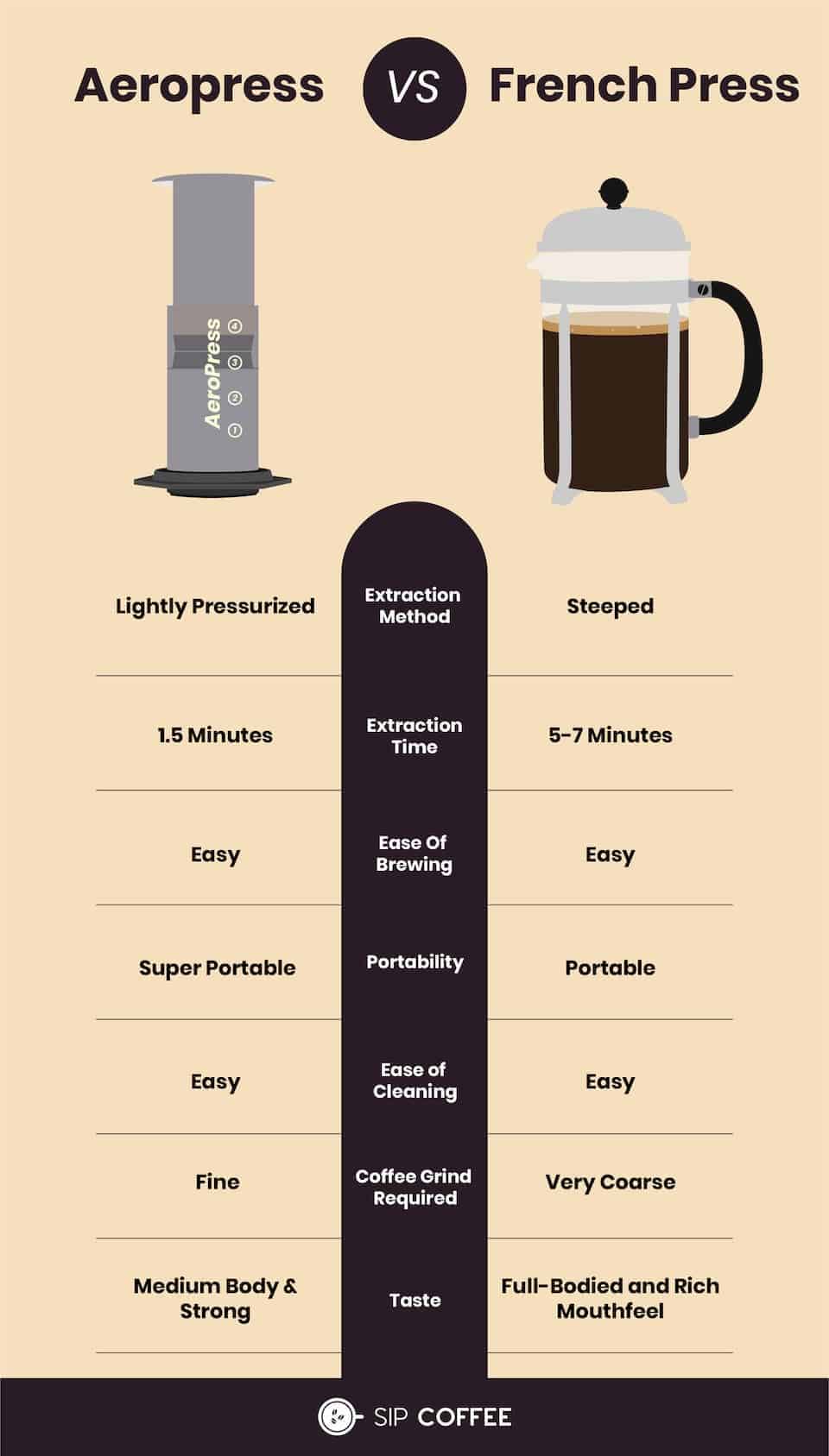
Flavor
Your average drip coffee maker doesn’t hold a torch to the flavor you can get from an AeroPress or French Press.
What’s so attractive about AeroPress? The clarity of flavors. The thin paper filter allows enough fine sediments through to provide a satisfying body while still producing a clean cup. Even the metal filter is thin enough that it produces a clean cup.
The flavor notes you’ll get out of a French Press may not inspire you to spout poetry. But if you love intense coffee, French Press might be your go-to brew method. French Press coffee is strong yet balanced.
Which brewing method should you use for different roasts?
If you have a light roast coffee…
Since AeroPress does provide that clarity of flavors, the best roast is a lighter roast. The brewer will enhance flavors in a lighter roast, whereas a dark roast doesn’t generally have those spectacular flavors to highlight.
If you have a dark roast coffee…
Brew it in the French Press to take advantage of the added intensity.
If you like strong, intense coffee…
Stick with the French Press. The coffee oils and sediment that pass through the metal filter give the coffee a boost of intensity.
Feel free though to experiment with AeroPress recipes that call for a generous bloom time, finely ground coffee, and longer brewing times.
You can also ditch the paper filter and use a metal one (like the one below)
If you like complex, bright coffee…
Go with the AeroPress. When I have a fruity coffee with amazing acidity I brew it in my AeroPress. The French Press will dull even the brightest of coffees.
Brewing Coffee Ease & Time
How easy is it to use?
Brewing is easy in both the French Press and AeroPress. All you need is coffee and hot water. No electricity, no fuss.
With both the AeroPress and French Press methods you heat the water first in a separate kettle. You add the coffee grounds to the brewing chamber and then add the hot water in both cases.
The AeroPress brews by forcing coffee through a thin paper filter or stainless-steel mesh filter set in the filter cap.
Put the filter in the filter cap and screw it onto the bottom chamber. Then set it on a coffee cup or mug. Add the coffee grounds and water, and then set the smaller tube inside the larger one.
Then pull back a bit on the smaller tube to create a seal. That way your coffee won’t leak out into your cup before it finishes brewing.
When the brewing time is up, just press on the top plunger, even and steady, until all the coffee is pressed out. This coffee-making syringe produces just a single serving size at a time, 8 ounces.
The AeroPress was originally created as a simple, manual way to produce a shot of espresso.
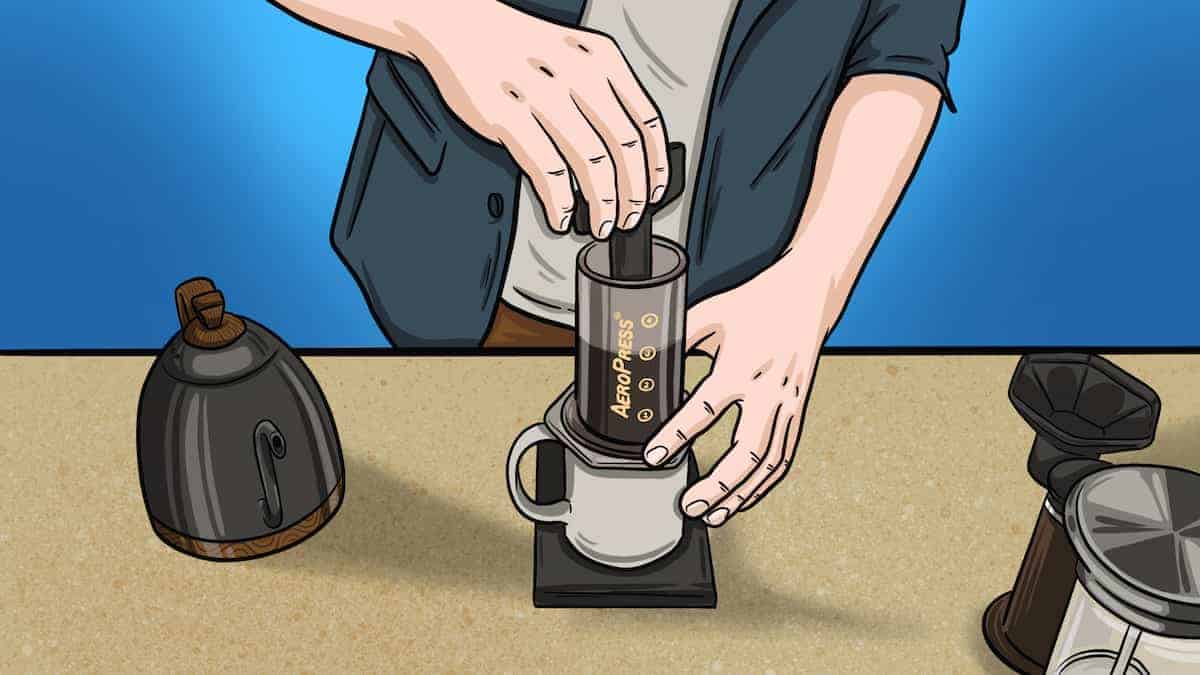
Which it doesn’t do. Why?
Making a shot of espresso requires a lot of pressure. An espresso machine uses 9 bars of pressure to create a shot. You need to have the espresso machine to get that kind of pressure – you can’t achieve it with a simple piston mechanism like the AeroPress.
But we don’t mind because an AeroPress still brews up some spectacular coffee.
Making coffee in an AeroPress does mean overcoming a learning curve that can feel quite steep in the beginning. The AeroPress is not intuitive like the easy French Press. But once you get the hang of the science behind it, you’ll realize it’s not that difficult.
The interesting aspect of brewing with an AeroPress is that you can brew it the standard way or you can flip the whole thing over and brew it upside down.
The inverted method means you don’t have to worry about getting a good seal. And it seems to brew a sweeter cup. A word of warning: it may take a few tries before you can flip it with no spills.
Versatility
Also, the AeroPress is versatile. You can experiment with recipes galore. Every year there are AeroPress championships held all over the world, and each competition launches a new series of recipes.
You can try those recipes out, which vary ratios, brewing times, stirring techniques, water temperature, grind size, and types of coffee beans and roasts.
The French Press is even easier to use. Put coarse ground coffee in the carafe and add hot water so the coffee steeps.
Wait for the brew time to be up, and then place the plunger on the top. Press it down slowly and carefully so that hot water doesn’t splash on you. Pour off the coffee into your cup.
As you can see, making coffee in a French Press is an almost brainless activity. For early mornings when I’m too tired to actually think while making coffee, I always reach for my French Press.
How quick does it brew?
Now let’s talk about the brew time. One of the big differences between an AeroPress and a French Press is in the brew time.
The creator of the AeroPress wanted a new way to brew coffee fast. He succeeded. The brew time for an AeroPress coffee is just a minute or two. (Although some of the best AeroPress recipes I’ve tried have gone over the 4-minute mark, including an unusual bloom time and a shockingly vigorous stir).
On the other hand, a French Press was invented when human beings still wanted the best things in life to be slow. So it demands a 3-5 minute brew time, or even longer if you listen to some French Press pros.
If you’re impatient for your cup of coffee, the 3-5 minute brew time can seem like an eternity. On the other hand, that’s unattended brewing time, so you can safely walk away from the brewer and come back when the steep time is over.
You don’t need to leave a bloom time in either method since they’re both immersion methods.
The grind size is different for the two brewing methods. AeroPress usually calls for fine grounds that will extract in that short brew time.
On the other hand, French Press coffee requires a coarse grind. If you didn’t use a coarsely ground coffee, it would pass through the metal filter and wind up in the drink. The coarse grind means the coffee grounds need to sit in the water for longer to extract well.
Which is better to use? Plunging a French Press is easy, while plunging an Aeropress can be a bit of a balancing act. So if you’re looking for the easiest method, go for a French Press.
The Aeropress is fast, while the typical French Press takes a few more minutes. Which you decide to use depends on your level of patience and your taste preferences.
Another point to mention is the size. You can get a large size French Press that makes multiple cups at one time. I have several styles that are ideal coffee makers when I brew for crowds.
But the AeroPress only comes in a single-serving size, the standard 10-ounce size, and a travel one that brews up an 8-ounce single cup.
If you want to make more than one cup of AeroPress or brew for a crowd of coffee drinkers, you’d need to brew several at a time. That would be a fun balancing act but not necessarily a pleasant one.
Portability
How portable are the AeroPress and French Press brew methods? That depends on how you plan to move it around.
If you’re looking for something that you can pop into your backpack, a glass French Press will never make the grade. You can buy either a glass or metal French Press, neither of which provide ease of travel.
Most French Presses are made of not-travel-friendly glass, which is easy to break. For coffee events that I have to travel to, I have stainless steel French Presses. But think about how heavy a steel coffee method feels in a suitcase.
The AeroPress, on the other hand, seems made for the road. For one, it’s compact. You can insert the top chamber into the bottom one.
Since the method is cylindrical, the internal area makes an ideal space to slip in a hand grinder, small baggie of coffee, or a stirring stick or spoon.
The method is made of virtually unbreakable plastic. It can take a beating in a backpack or suitcase.
It also weighs about 6 ounces, which no one will complain about. If you use a metal mesh filter, you don’t even have to worry about taking a filter pack with you.
You’re ready for the road with a minimum of fuss. An Aeropress is often sold with a travel bag.
For travel, I always turn to my lightweight AeroPress. There’s also a Go Travel Coffee Press that makes it even easier to pick up and travel with your AeroPress.
The upper chamber is slightly shorter, and it comes in a compact container that acts as a brewing recipient and drinking cup.
Cleaning Ease
Both the AeroPress and French Press are rather easy to clean.
The pressure you use to brew an AeroPress makes cleaning up easier. The piston presses the coffee grounds into a dry puck at the bottom.
Just take off the filter basket and pop that puck into the trash, with no mess. Then give the method a simple rinse under running water. The manufacturer recommends not using soap. The oils from the coffee don’t accumulate on the polypropylene body.
A French Press pot is a bit more involved to clean. Since you don’t use paper filters, you need to strain the used coffee grounds.
I often have coffee grounds all over the kitchen sink. Then you need to wash a glass carafe with water and rinse the filter. It’s not complicated, but it does take a few more minutes than an AeroPress.
If your kitchen sink drain is at risk of getting clogged, make sure you don’t wash any coffee grounds down.
If you have a garden or house plants where you can deposit the coffee grounds, fantastic. They make an ideal fertilizer for many plants. If you don’t, use a strainer to catch the grinds and then put them in the trash bin.
Wrapping Up: AeroPress Or French Press Coffee
The AeroPress and French Press are brewing devices loved by coffee enthusiasts.
The AeroPress will wow you with the flavors. The method will last a long time since breaking one is nearly impossible. It’s portable and easy to clean. On the downside, an AeroPress serves up one single cup at a time.
And you do need to get through that learning curve and have enough arm muscle to get that piston down. Messing up with the recipe means coffee you need to toss down the drain.
A French Press is easy to use and always provides a bold coffee with a satisfying body. It’s easy to set up. You don’t have to fuss with a French Press while it’s brewing, and it’s easy to press the plunger down.
But a French Press can only be brewed in one way, so there’s not much room for creativity. Also, the flavors tend to be a bit muddled, giving you a strong coffee that you can’t say too much else about.
Which is the best brewing device for you? That depends on your taste preferences and what you consider to be a perfect cup.
The good thing about brewing coffee is that we don’t have to choose just one method. And since both these brew methods are quite inexpensive and easy to store, it’s not a problem for a coffee drinker to have them both in their kitchen.

